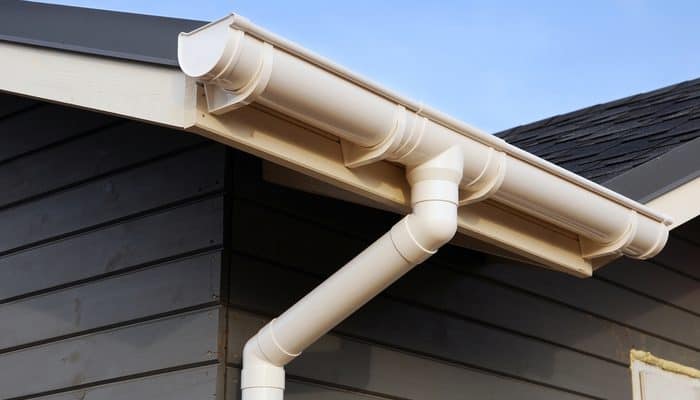
Gutters are simple devices that redirect the flow of water off of a roof. However, they require some precise calculations to work well.
The amount by which gutters slant downward along the path of water flow is called their pitch. If your gutters are not pitched properly, they may pool or even spill over their sides.
Measure The Roof
The roof’s pitch determines the gutter’s slope, which in turn affects how much water it can carry. Gutters without a proper slope can collect more water than they can drain, leading to overflows and structural damage. Choosing the right gutter pitch ensures that water flows smoothly and efficiently, safeguarding your home against expensive damage.
To measure your roof’s pitch, use a level and a tape measure. Start at one end of your gutter and note its height, then move to the opposite side and repeat the process, comparing each measurement with the first. If the measurements are different, find the average and use that number.
If you’re installing new gutters, take the total length of your gutters into account as well, as this will influence the size of downspouts you need to accommodate that amount of water. A general rule of thumb is a quarter inch of slope for every 10 feet of gutter, so multiply your gutters’ length by that number to get the correct slope.
Once you’ve determined your gutter slope, look up the maximum rainfall intensity for your area in the U.S. Weather Bureau’s database to see how big a gutter you need. You can also consult a professional to measure your gutters’ depth and width for you, but this step is essential in ensuring that your gutters are properly sized to handle the local climate.
Measure The Gutters
Gutters that are properly sized help to protect your roof, foundation, landscaping and house’s exterior from water damage. Choosing the right gutters is not as hard as it might seem and is easily determined by using a few simple calculations. All that’s needed is the drainage area of your roof, its roof-pitch factor and your home’s maximum rainfall intensity.
Measure the length of your gutters with a tape measure and record this information for later use. Using a ladder and a steady hand, carefully extend the tape measure along the gutters from both ends to the midpoint and take the average of these three measurements.
If the gutters are not pitched correctly, water collects in them, creating stagnant pools that can lead to mold growth, rust and insect infestations. These pools also increase the weight of the gutters and can cause them to loosen or fall off the home’s fascia.
The recommended gutter slope is 1/2 inch for every 10 feet of gutters. For gutters that span over 30 feet, it’s a good idea to pitch the gutter in two sections with downspouts on both ends. This way, if one end of the gutter is higher than the other, you can adjust it to create a smooth, gradual slope from both ends to the downspouts. The high point should be near the downspout and the low point should be near the opposite end of the gutter.
Measure The Downspouts
A gutter system with an improper pitch can create gaps where water escapes from the gutter. This can damage the siding and eroding brickwork on your home, and it will also allow mildew and other organic materials to collect in the gutters. This can lead to the need for gutter repair and cleaning services in the future.
To measure your gutters’ pitch, you’ll need to use a ladder, and you should wear work gloves, safety goggles, and nonslip shoes. Position the ladder on a stable surface and be sure to have someone nearby to steady it. It is best to perform this job on a calm day, as rain or wind will make the ladder less stable and could cause an accident.
Start at one end of the gutter and measure to its midpoint. Repeat the process at the other end of the gutter, then take an average of these measurements. You’ll want to add the width of two gutter elbow pieces to this total, as you’ll need these to connect your downspouts.
You’ll also need to decide how many downspouts you will require for each section of the gutter, as well as their location. Generally, it is recommended to have one downspout for every 25-30 linear feet of gutter. This will help to ensure the proper flow of water, as well as prevent downspouts from overflowing during a heavy rainfall.
Test The Gutters
Whether you’re repairing existing gutters or installing new ones, it’s a good idea to test them with water. Pouring water from a bucket or hose over different parts of the gutters gives you an idea of how the system is functioning and what kind of flow it’s creating, which can help you spot issues before they cause real damage. It also allows you to check if your gutters are pitched properly.
The pitch, or angle, of gutters is a critical factor in the speed and ease with which water drains from them. If the pitch is off, the water may sit in the gutters, leading to sludge buildup and overflowing. This can also cause damage to the home’s exterior and landscaping. Gutters that are properly pitched will move water quickly to the downspouts and away from the house, preventing wood rot in soffits and fascia boards.
It’s important to keep in mind that the recommended gutter slope varies slightly from expert to expert, but most recommend a 1/4 inch of slope for every 10 feet of gutter. This means that for a 25-foot gutter run, the end with the downspout should be set about 5/8 of an inch lower than the other/higher end. This is designed to ensure a steady but gentle flow of water into the downspout, without causing erosion or overflow.






























